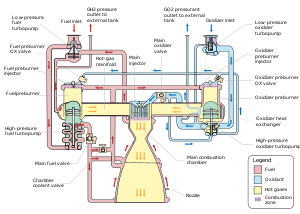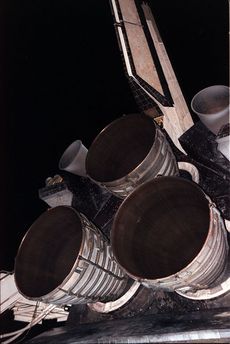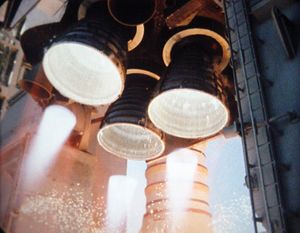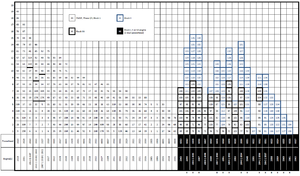آر إس-25
 RS-25 test firing (the bright area at the bottom of the picture is a Mach diamond) | |
| بلد الأصل | الولايات المتحدة |
|---|---|
| أول طيران | 12 أبريل 1981 (STS-1) |
| الصانع | Rocketdyne, Pratt & Whitney Rocketdyne, Aerojet Rocketdyne |
| مركبة الإطلاق المقترنة | مكوك الفضاء نظام الإطلاق الفضائي |
| السابق | HG-3 |
| الوضع | Out of service since STS-135, in testing for SLS |
| سائل | |
| النسق | |
| نسبة الفوهة | 69:1[1] |
| الأداء | |
| الدفع (فراغ) | 512,300 lbf (2,279 kN)[1] |
| الدفع (SL) | 418,000 lbf (1,860 kN)[1] |
| نسبة الدفع إلى الوزن | 73.1[2] |
| ضغط التجويف | 2,994 psi (20.64 MPa)[1] |
| دنو (فراغ) | 452.3 seconds (4.436 km/s)[1] |
| دنو (SL) | 366 seconds (3.59 km/s)[1] |
| الأبعاد | |
| الطول | 168 inches (4.3 m) |
| القطر | 96 inches (2.4 m) |
| الوزن الجاف | 7,775 pounds (3,527 kg) |
| المراجع | |
| المراجع | [3][2] |
| ملاحظات | Data is for RS-25D at 109% throttle. |
The Aerojet Rocketdyne RS-25, otherwise known as the Space Shuttle main engine (SSME),[4] is a liquid-fuel cryogenic rocket engine that was used on NASA's Space Shuttle. NASA is planning to continue using the RS-25 on the Space Shuttle's successor, the Space Launch System (SLS).
Designed and manufactured in the United States by Rocketdyne (later known as Pratt & Whitney Rocketdyne and Aerojet Rocketdyne), the RS-25 burns cryogenic liquid hydrogen and liquid oxygen propellants, with each engine producing 1,859 kN (418,000 lbf) of thrust at liftoff. Although the RS-25 can trace its heritage back to the 1960s, concerted development of the engine began in the 1970s, with the first flight, STS-1, occurring on April 12, 1981. The RS-25 has undergone several upgrades over its operational history to improve the engine's reliability, safety, and maintenance load.
The engine produces a specific impulse (Isp) of 452 seconds (4.43 km/s) in a vacuum, or 366 seconds (3.59 km/s) at sea level, has a mass of approximately 3.5 tonnes (7,700 pounds), and is capable of throttling between 67% and 109% of its rated power level in one-percent increments. The RS-25 operates at temperatures ranging from −253 °C (−423 °F) to 3300 °C (6000 °F).[1]
The Space Shuttle used a cluster of three RS-25 engines mounted in the stern structure of the orbiter, with fuel being drawn from the external tank. The engines were used for propulsion during the entirety of the spacecraft's ascent, with additional thrust being provided by two solid rocket boosters and the orbiter's two AJ10 orbital maneuvering system engines. Following each flight, the RS-25 engines were removed from the orbiter, inspected, and refurbished before being reused on another mission.
المكونات
Turbopumps
نظام المؤكسد
نظام الوقود
Powerhead
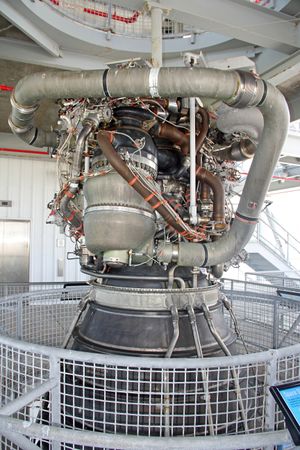
Preburners
غرفة الاحتراق الرئيسية
Nozzle
جهاز التحكم
الصمامات الرئيسية
Gimbal
نظام الهليوم
التاريخ
التطوير
برنامج مكوك الفضاء
التحديثات
Engine throttle/output
| مستوى سمطح البحر | Vacuum | |
|---|---|---|
| 100% thrust | 2,094.22272928 kN (470,799.99838 lbf) | 2,120 kN (480,000 lbf) |
| 104.5% thrust | 1,750 kN (390,000 lbf) | 2,170 kN (490,000 lbf) |
| 109% thrust | 1,860 kN (420,000 lbf) | 2,280 kN (510,000 lbf) |
حوادث
Constellation
نظام الإطلاق الفضائي
اختبارات المحرك
إكس إس-1
انظر أيضاً
الهوامش
المصادر
- ^ أ ب ت ث ج ح خ Aerojet Rocketdyne, RS-25 Engine (accessed July 22, 2014)
- ^ أ ب Wade, Mark. "SSME". Encyclopedia Astronautica. Retrieved December 28, 2017.
- ^ "Space Shuttle Main Engine" (PDF). Pratt & Whitney Rocketdyne. 2005. Archived from the original (PDF) on February 8, 2012. Retrieved November 23, 2011.
- ^ "RS-25 Engine".
- ^ خطأ استشهاد: وسم
<ref>غير صحيح؛ لا نص تم توفيره للمراجع المسماةOrientation
